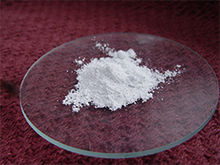Strontium carbonate

| |
| Names | |
|---|---|
| IUPAC name
Strontium carbonate
| |
| Other names | |
| Identifiers | |
3D model (JSmol)
|
|
| ChemSpider | |
| ECHA InfoCard | 100.015.131 |
PubChem CID
|
|
| RTECS number |
|
| UNII | |
CompTox Dashboard (EPA)
|
|
| |
| |
| Properties | |
| SrCO3 | |
| Molar mass | 147.63 g/mol |
| Appearance | White or grey powder hygroscopic |
| Odor | Odorless |
| Density | 3.5 g/cm3 |
| Melting point | 1290 ºC decomp. |
| 0.0011 g/100 ml (18 ºC) | |
Refractive index (nD)
|
1.518 [1] |
| Hazards | |
| NFPA 704 (fire diamond) | |
| Flash point | Non-flammable |
| Related compounds | |
Other cations
|
Magnesium carbonate Calcium carbonate Barium carbonate |
Except where otherwise noted, data are given for materials in their standard state (at 25 °C [77 °F], 100 kPa).
| |
Strontium carbonate (SrCO3) is the carbonate salt of strontium that has the appearance of a white or grey powder. It occurs in nature as the mineral strontianite.
Chemical properties
Strontium carbonate is a white, odorless, tasteless powder. Being a carbonate, it is a weak base and therefore is reactive with acids. It is otherwise stable and safe to work with. It is practically insoluble in water (1 part in 100,000). The solubility is increased significantly if the water is saturated with carbon dioxide, to 1 part in 1,000. It is soluble in dilute acids.
Preparation
Other than the natural occurrence as a mineral, strontium carbonate is prepared synthetically in one of two manners. First of which is from naturally occurring celestine also known as strontium sulfate (SrSO4) or by using soluble strontium salts by the reaction in solution with a soluble carbonate salt (usually sodium or ammonium carbonates). For example if sodium carbonate was used in solution with strontium nitrate:
Sr(NO3)2 (aq) + Na2CO3 (aq) → SrCO3 (s) + 2 NaNO3 (aq).
Uses

The most common use is as an inexpensive colorant in fireworks. Strontium and its salts emit a brilliant red color in flame. Unlike other strontium salts, the carbonate salt is generally preferred because of its cost and the fact that it is not hygroscopic. Its ability to neutralize acid is also very helpful in pyrotechnics. Another similar application is in road flares.
Strontium carbonate is used for electronic applications. It is used for manufacturing CTV to absorb electrons resulting from the cathode.
It is used in the preparation of iridescent glass, luminous paints, strontium oxide or strontium salts and in refining sugar.
It is widely used in the ceramics industry as an ingredient in glazes. It acts as a flux and also modifies the color of certain metallic oxides. It has some properties similar to barium carbonate.
It is also used in the manufacturing of strontium ferrites for permanent magnets which are used in loud speakers and door magnets.
Because of its status as a weak Lewis base, strontium carbonate can be used to produce many different strontium compounds by simple use of the corresponding acid.
References
- ^ Pradyot Patnaik. Handbook of Inorganic Chemicals. McGraw-Hill, 2002, ISBN 0070494398
External links
- [1] Reference page at CeramicMaterials.Info
- International Chemical Safety Card 1695

